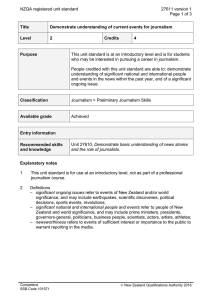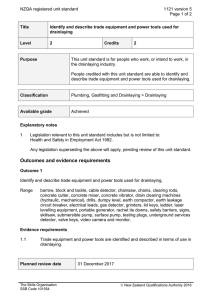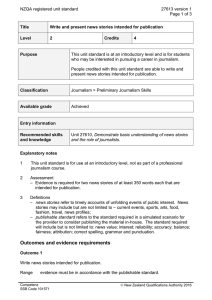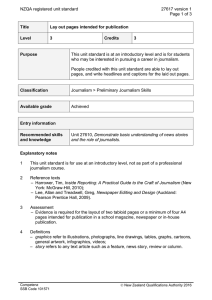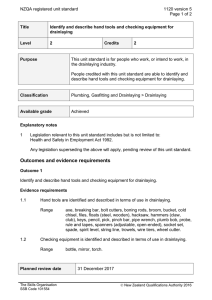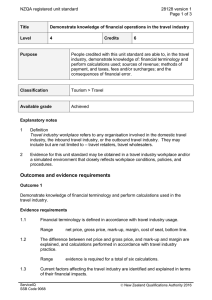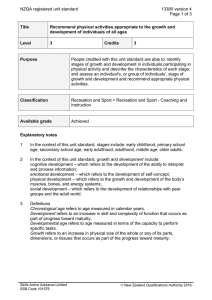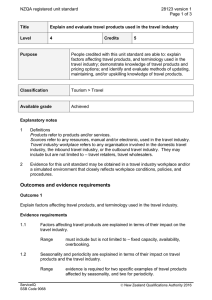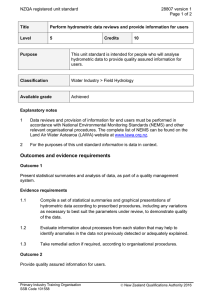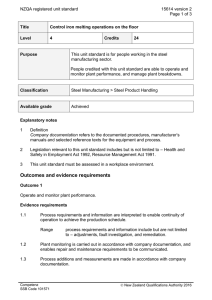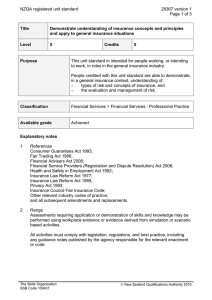NZQA registered unit standard 27610 version 1 Page 1 of 3
advertisement
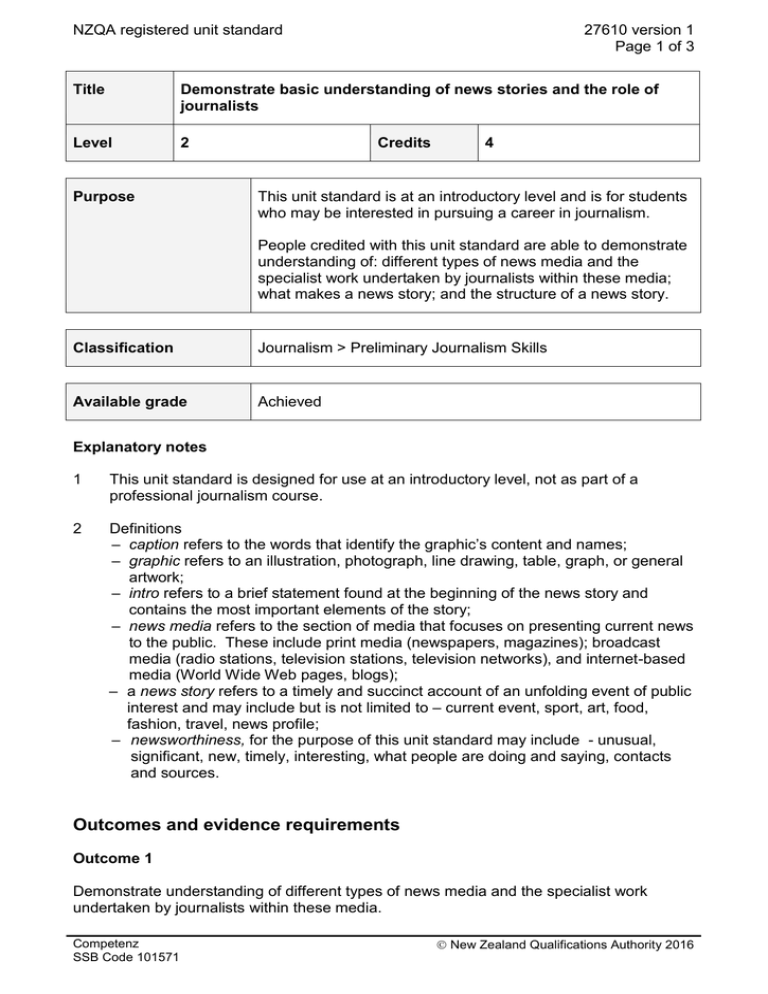
NZQA registered unit standard 27610 version 1 Page 1 of 3 Title Demonstrate basic understanding of news stories and the role of journalists Level 2 Purpose Credits 4 This unit standard is at an introductory level and is for students who may be interested in pursuing a career in journalism. People credited with this unit standard are able to demonstrate understanding of: different types of news media and the specialist work undertaken by journalists within these media; what makes a news story; and the structure of a news story. Classification Journalism > Preliminary Journalism Skills Available grade Achieved Explanatory notes 1 This unit standard is designed for use at an introductory level, not as part of a professional journalism course. 2 Definitions – caption refers to the words that identify the graphic’s content and names; – graphic refers to an illustration, photograph, line drawing, table, graph, or general artwork; – intro refers to a brief statement found at the beginning of the news story and contains the most important elements of the story; – news media refers to the section of media that focuses on presenting current news to the public. These include print media (newspapers, magazines); broadcast media (radio stations, television stations, television networks), and internet-based media (World Wide Web pages, blogs); – a news story refers to a timely and succinct account of an unfolding event of public interest and may include but is not limited to – current event, sport, art, food, fashion, travel, news profile; – newsworthiness, for the purpose of this unit standard may include - unusual, significant, new, timely, interesting, what people are doing and saying, contacts and sources. Outcomes and evidence requirements Outcome 1 Demonstrate understanding of different types of news media and the specialist work undertaken by journalists within these media. Competenz SSB Code 101571 New Zealand Qualifications Authority 2016 NZQA registered unit standard 27610 version 1 Page 2 of 3 Evidence requirements 1.1 Key features of the different types of news media are described and supporting examples for one type of media are presented. 1.2 Specialist skills required by journalists are described in terms of the different roles within a newsroom and supporting examples of each skill are provided. Range 1.3 specialist roles include but are not limited to – reporter, sub-editor, editor; skills required may include but are not limited to – finding and presenting information, decision making, workflow, contribution to each other. Key requirements for becoming a successful journalist are described and supporting examples are provided. Range may include but is not limited to – enquiring mind, ability to find news, ability to research, broad general knowledge, ability to write a compelling story, accuracy, timeliness, sticking to facts, simplicity, knowing the market (target audience), awareness of competition, discipline, being realistic, maintaining regular communications. Outcome 2 Demonstrate understanding of what makes a news story. Evidence requirements 2.1 Principles for deciding when a story is news are described. Range 2.2 unusual, significant, new, timely, interesting, what people are doing and saying, contacts and sources. Events and activities from which news arises are identified and their potential newsworthiness explained. Range events and activities may include but are not limited to – disaster and tragedy, conflicts, progress and development, crime, money, religion, famous people, health, weather, food and drink, entertainment, sport, human interest, politics; evidence is required from three published news stories which must cover separate events and activities. Outcome 3 Demonstrate understanding of the structure of a news story. Range the news story must be one published in a daily newspaper. Competenz SSB Code 101571 New Zealand Qualifications Authority 2016 NZQA registered unit standard 27610 version 1 Page 3 of 3 Evidence requirements 3.1 The main elements that make up the news story are identified and explained. Range who, what, when, where, why, how. 3.2 The intro for the news story is identified and its purpose explained. 3.3 The inverted pyramid is explained in terms of the news story’s structure. 3.4 Captions and graphics are identified and described in terms of their relationship to the news story. Planned review date 31 December 2016 Status information and last date for assessment for superseded versions Process Version Date Last Date for Assessment Registration 1 19 January 2012 N/A Consent and Moderation Requirements (CMR) reference 0002 This CMR can be accessed at http://www.nzqa.govt.nz/framework/search/index.do. Please note Providers must be granted consent to assess against standards (accredited) by NZQA, before they can report credits from assessment against unit standards or deliver courses of study leading to that assessment. Industry Training Organisations must be granted consent to assess against standards by NZQA before they can register credits from assessment against unit standards. Providers and Industry Training Organisations, which have been granted consent and which are assessing against unit standards must engage with the moderation system that applies to those standards. Requirements for consent to assess and an outline of the moderation system that applies to this standard are outlined in the Consent and Moderation Requirements (CMR). The CMR also includes useful information about special requirements for organisations wishing to develop education and training programmes, such as minimum qualifications for tutors and assessors, and special resource requirements. Comments on this unit standard Please contact Competenz info@competenz.org.nz if you wish to suggest changes to the content of this unit standard. Competenz SSB Code 101571 New Zealand Qualifications Authority 2016
